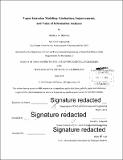Vapor intrusion modeling : limitations, improvements, and value of information analyses
Author(s)
Friscia, Jessica M. (Jessica Marie)
DownloadFull printable version (16.57Mb)
Other Contributors
Massachusetts Institute of Technology. Department of Civil and Environmental Engineering.
Advisor
David E. Langseth.
Terms of use
Metadata
Show full item recordAbstract
Vapor intrusion is the migration of volatile organic compounds (VOCs) from a subsurface source into the indoor air of an overlying building. Vapor intrusion models, including the Johnson and Ettinger (J&E) model, can be used to predict the concentration of VOCs in the indoor air of a building based on a measured subsurface soil gas concentration or contaminant source concentrations, either in non-aqueous phase liquid (NAPL), groundwater, or soil. An analysis of two of the EPA-implemented J&E spreadsheet models, one that considers subsurface soil gas data and one that considers groundwater data, was conducted. The governing equations, assumptions, and limitations of these spreadsheet models were investigated. A value of information (Vol) worksheet was developed that can assist practitioners in deciding what additional data to collect as part of a remedial investigation. The Vol worksheet calculates how varying values of model input parameters affect the model-predicted indoor air carcinogenic risk. The worksheet then compares the user-defined target risk to the range of potential risk values for different combinations of varying parameters. The results of this analysis allow the user to determine which groups of parameters have the most impact on the model results. This information can assist the practitioner in deciding whether or not to collect additional data to reduce the uncertainty in the input parameters. The EPA J&E soil gas and groundwater spreadsheet models, as well as the Vol worksheet developed for each model, were applied to case study data for a trichloroethylene-impacted site in Rhode Island. The results of the J&E model and Vol worksheet analyses for this case study predicted incremental carcinogenic risk values for trichloroethylene (TCE) below the risk value calculated based on measured indoor air data. This comparison suggests the potential for other sources of TCE within the building. Groups of parameters were identified for each model that impacted the model-predicted carcinogenic risk. The development of a cost-benefit analysis, which would be used to quantify the value of obtaining additional data for these critical parameters, is recommended for future research.
Description
Thesis: M. Eng., Massachusetts Institute of Technology, Department of Civil and Environmental Engineering, 2014. Cataloged from PDF version of thesis. Includes bibliographical references (pages 84-89).
Date issued
2014Department
Massachusetts Institute of Technology. Department of Civil and Environmental EngineeringPublisher
Massachusetts Institute of Technology
Keywords
Civil and Environmental Engineering.